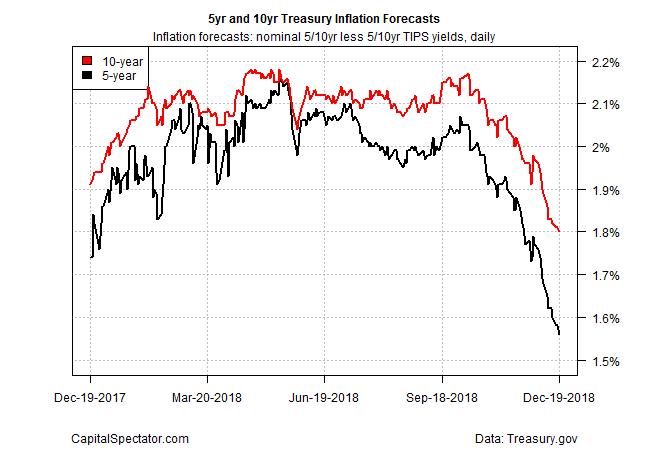The Federal Reserve’s decision to raise interest rates yesterday emboldened the Treasury market to reprice inflation expectations to the downside. The softer outlook on pricing pressure follows several months of lower inflation forecasts, based on the yield spreads on nominally priced government bonds less their inflation-indexed counterparts. If recent history is a guide, the crowd looks set to cut inflation estimates further in the weeks ahead and thereby raise questions about the wisdom of monetary policy.
At the close of trading, the yield spread for 5-year Treasuries dipped to 1.56%, the lowest since August 2017. This widely followed gauge of future inflation is now more than 40 basis points below the Fed’s 2.0% inflation target — a sign that the central bank’s monetary policy may be at risk of promoting a new round of disinflation at a time when projections for economic growth are slipping.

Fed Chairman Jerome Powell in a press conference yesterday noted that while a “robust economic backdrop” continue to support “our expectation for healthy growth, we have seen developments that may signal some softening.” That didn’t stop the central bank from another round of tightening (the target Fed funds rate was increased 25 basis points to a 2.50%-to-2.75% range) — or the Treasury market from lowering its inflation outlook.
Critics of the market’s implied inflation forecast point out that this real-time estimate is volatile and suffers a mixed record on accurately predicting pricing pressure. Nonetheless, the ongoing slide in this yield spread for government bonds is a sign that the crowd is telling the Fed that monetary policy is becoming too hawkish for the current economic outlook.
Earlier this week The Capital Spectator reported that US GDP growth looks set to slow in the fourth quarter (based on the median nowcast via several sources). Although the projected 2.7% increase in output (seasonally adjusted annual rate) is still a healthy pace, the estimate reflects a second quarter of deceleration. The worry in some corners is that the Fed’s latest rate hike will contribute to ongoing deceleration in output in 2019.
In fact, the Federal Reserve trimmed its outlook for GDP growth for this year and in 2019. Yesterday’s revised estimates see output for all of 2018 rising 3.0%, down from a 3.1% forecast in September. The Fed also cut its 2019 growth outlook to 2.3% from the previous 2.5% estimate.
The sharp decline in the US stock market following the Fed announcement adds to the sense that market expectations are now discounting a weaker macro trend. The S&P 500 Index fell 1.5% yesterday, dropping to a 15-month low.
Apparently factoring in the weaker economic expectations, Powell hinted that the Fed’s rate hikes will slow or perhaps end next year. “There’s significant uncertainty about both the path and the ultimate destination of any further rate increases,’’ he said at yesterday’s press conference.
Tim Duy, an economist at the University of Oregon who follows Fed policy closely, worries that that the central bank “is currently a slave to its own models” and so it’s at risk of falling short of its inflation target.
It is an unnecessarily and explicit hawkish message that is an artifact of a communications strategy that only made sense when you could reasonably promise zero rates for an extended period. It makes no sense to create the impression of a promise to continue to raise interest rates at a mature point in the business cycle when growth is already slowing.
The jury is still out on whether the the Fed’s latest rate hike (or any future hikes) are a clear policy mistake, but the risk on that front is rising.
“In a risk management framework, the Fed would have been wise to skip this meeting and put January in play,” Duy notes. “By not doing so, I fear the Fed may flip uncomfortably close to my alternative scenario – that they continue hiking until something breaks.”
